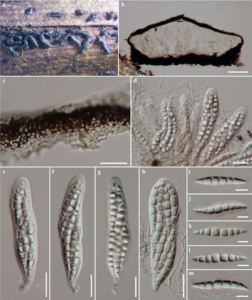Psiloglonium multiseptatum Phookamsak & K.D.Hyde.
Index Fungorum number: IF550931, Facesoffungi number: FoF00434; Fig. 1
Etymology – The specific epithet multiseptatum refers to the septation of the ascospores.
Holotypus – MFLU 11–0200
Saprobic on stemof Thysanolaena maxima. Sexual morph Ascomata 130 – 265 μm high, 450 – 1000 μm diam., hysterothecial, solitary to gregarious, scattered, superficial, elongate, cupulate to lenticular, or irregular, joined at the ridges, slightly straight, with central slit-like opening. Peridium 4 – 20 μm wide, thin-walled, of unequal thickness, thick at the base and sides, carbonaceous, composed of several layers of small, opaque, dark cells, arranged in textura angularis to textura globulosa. Hamathecium 0.5 – 2 μm wide, composed of dense, trabeculate, anastomosing, pseudoparaphyses, embedded in a hyaline to brown gelatinous matrix. Asci (86–) 90 – 110 (–118) × (19–) 22 – 23 (–27) μm (x̄ = 104.5 × 22.6 μm, n = 25), 8 – spored, bitunicate, fissitunicate, cy-lindric-clavate to clavate, subsessile to short pedicellate with furcate pedicel, apically rounded, with indistinct ocular chamber, easily broken in external layer. Ascospores (38.5–) 46 – 51 (–53) × (6–) 7 – 8 (–9) μm (x̄ = 47.6 × 7.6 μm, n = 30), overlapping 2 – 4 – seriate, elongated fusiform, with acute ends, hyaline, 5 – 7 – septate, constricted at the septum, easily separated in to part ascospores, smooth-walled, surrounded by distinct mucilaginous sheath. Asexual morph Undetermined.
Culture characters – Colonies on PDA slow growing, 10 – 15 mm diam. after 4 weeks at 25 – 30 °C, dark grey to dark greenish at the magins, yellowish in centre; reverse dark grey to black; dense, circular to slightly irregular, raised to low umbonate, dull, undulate edge with entire margin, felty, with hard small granules, standing or tufts of yellowish hyphae, producing dark brown pigments in agar.
Material examined – THAILAND, Chiang Mai Province, Chom Tong District, Doi Inthanon, on dead stem of Thysanolaena maxima Kuntze (Poaceae), 6 October 2010, R. Phookamsak RP0080 (MFLU 11–0200, holotype), ex-type living culture, MFLUCC 11–0164; GenBank LSU:KP744512; SSU: KP753969.
Notes – Psiloglonium multiseptatum is introduced to accommodate a gloniella-like species which is similar to Gloniella bambusae Zogg and G. normandina Rehm in having transseptate ascospores, but differs in the size range. Psiloglonium multiseptatum has larger ascospores (46 – 51 × 7 – 8 μm) than Gloniella bambusae H. Zogg (30 – 35 × 5 – 8 μm) and G. normandina Rehm (22 – 25 × 3 – 3.5 μm) (Rehm 1912; Boehm 2009). Based on multi-gene phylogenetic analyses, Psiloglonium multiseptatum groups in a clade with P. araucanum and is placed in Psiloglonium and not Gloniella.

Fig. 1 Psiloglonium multiseptatum (holotype) a Hysterothecia on host surface b Vertical section through a hysterothecium c Peridium d Asci embedded in pseudoparaphyses e–h Asci. i–m Ascospores Scale bars: b = 100 μm, c – h = 20 μm, i – m = 10 μm.
